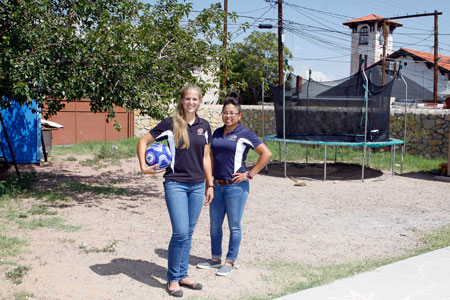Originally published Oct. 9, 2015
By Laura L. Acosta
UTEP News Service
Physical therapy got Kiersten Garrand back on the soccer field after suffering ankle and knee injuries in high school.
The Florida native was so impressed with how the physical therapists used exercise and strength training to help her get back on her feet that Garrand decided to follow in their footsteps.

Garrand is in the second year of the Doctor of Physical Therapy Program (DPT) at The University of Texas at El Paso. The program has not only made it possible for her to study physical therapy, but it has also opened the doors for her to participate in research and community service.
Since May, Garrand, a research assistant in the DPT program, has been working on a project to identify the different teaching strategies that physical therapy educators in the United States use to educate students about patients with disabilities
Garrand has been collaborating with UTEP Associate Professor Celia Pechak, Ph.D.; Liliana Jimenez, a first-year student in UTEP’s Doctor of Physical Therapy Program (DPT); and Nancy Gell, Ph.D., an assistant professor of rehabilitation and movement science at The University of Vermont, on the project. Results will be used to develop teaching strategies that will enhance how disability-related competencies are taught at UTEP and at physical therapy programs across the U.S.
“There’s really not a lot of research saying that this (teaching method) is effective in training students to work with people with disabilities,” said Garrand, who expects to graduate from UTEP’s DPT program in 2016. “A lot of health care providers go out into the world and they’re still uncomfortable and nervous treating people with disabilities. We learn a lot about people with disabilities in class and the treatments they need, but it’s very different when it’s hands on.”
Nearly 20 percent of Americans have a disability. In the U.S., people with disabilities are more likely to experience health care disparities than the rest of the population. The Equal Rights Center reported that a widespread lack of awareness about disability within the health care industry has created a barrier to medical care access for individuals with disabilities.
Research suggests that one way to reduce health care disparities among people with disabilities is to teach disability-related content to health professions students.
Garrand’s research has already prepared her to become a better physical therapist, said Pechak, who is also the interim associate director of UTEP’s DPT program.
“(The research has) deepened her understanding of research methods, which will directly benefit her ability to be an excellent clinician,” Pechak said. “Physical therapists need to be able to apply current research to optimally serve their patients.”
This past summer, Garrand surveyed 217 physical therapy programs in the U.S. to identify how clinicians train their students about disabilities, including simulation scenarios, class lectures, textbooks and community clinical experiences.
“If a patient has a hearing impairment or if they’re psychologically or cognitively impaired, then we need to approach them differently,” Garrand explained. “In the classroom we practice on each other, but it’s hard to simulate a disability.”
During the spring semester, Garrand and her classmates had the opportunity to interact with patients from Mentis Neuro Rehabilitation in El Paso. Students not only practiced their assessment skills, but they also were able to engage patients one-on-one.
Jimmy Moody, clinical coordinator at Mentis in El Paso, said these types of hands-on experiences allow students to focus on the patients’ abilities rather than their disabilities while they practice the skills they’ve learned in class.
“As health care providers, we need to have that attitude that we’re not trying to find something wrong with a patient,” said Moody, a UTEP graduate. “We’re trying to find what they’re able to do and their unique talents and strengths and put that into function in their daily lives.”
About 40 percent of the programs Garrand contacted have responded to the survey. She will analyze the data this fall and hopes to present her findings at the 2015 UTEP Graduate Student Expo in November. She also plans to work with Pechak on a manuscript for the Journal of Physical Therapy Education.
“This research is not really limited to physical therapy,” Garrand said. “All these other programs, whether its occupational therapy, speech language pathology, rehabilitation counseling or even nursing, they work with people with disabilities. So if we can pass on any of our knowledge or training that we deem effective from our research, then it could really benefit all of UTEP and the health sciences.”
The DPT program has also offered Garrand opportunities to engage in the community. After participating in a service learning course at La Posada Home, a homeless shelter for women and children in downtown El Paso, in 2014, Garrand and DPT student Amber Flores were inspired to build a soccer field for children at the shelter.
Their goal is to raise $7,000 to lay down a synthetic turf in La Posada’s backyard by Christmas and purchase a net, soccer balls and athletic shoes for the children. Garrand and Flores have organized small fundraisers and they’ve also set up a GoFundMe page.
Garrand said when she and Flores weren’t helping the children with homework, the two students spent most of their time playing soccer with the kids in the backyard.
“There are just rocks, nails and old boards back there and the kids kept falling and hurting themselves,” Garrand recalled. “All the kids wanted to do was play soccer. We decided to make them a soccer field because we wanted to do something for them to make them happy. This is our way of giving back.”